Gardner Museum Heist —Blog
Most recently, in March of 2019, Abath posted a third version of the first chapater of his book on the case, which he has been sharing with the press and or posting online since 2013.
Whether he has gotten past the first chapter, or ever will, remains to be seen. Continued...
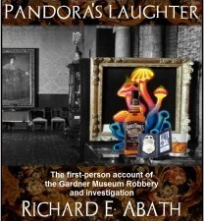
April 15, 2020: 'Deflections,' a Gardner Museum Robbery Slideshow
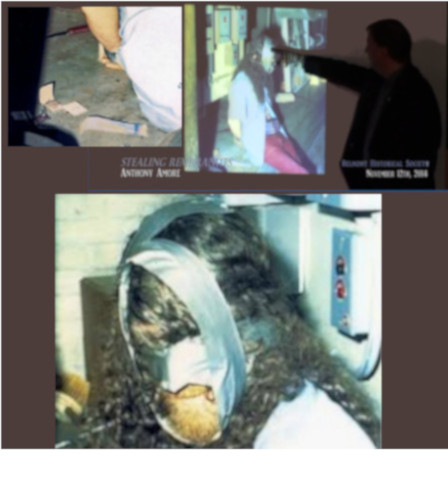
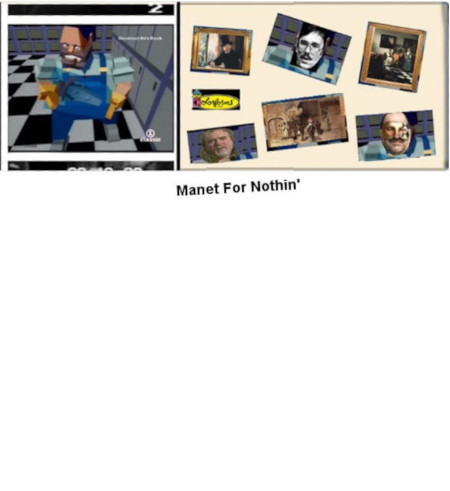
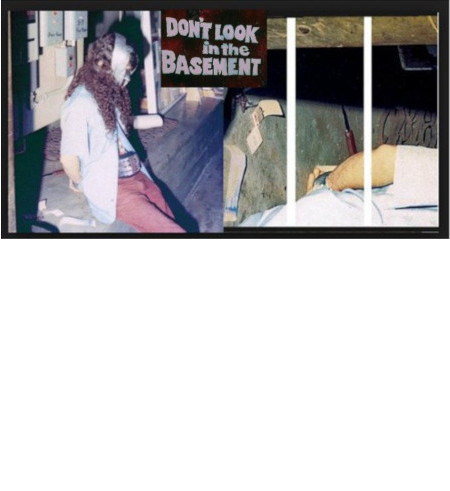
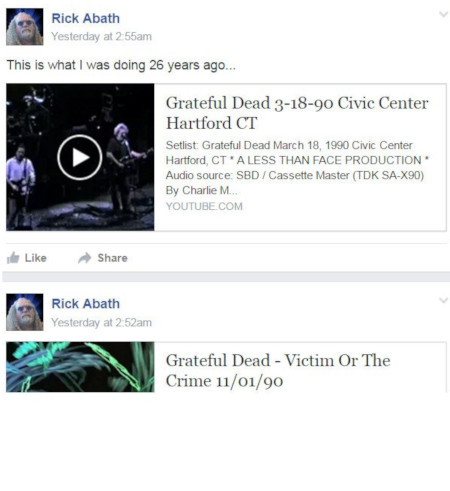
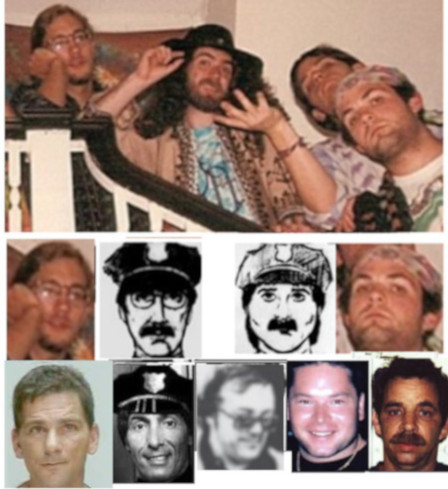
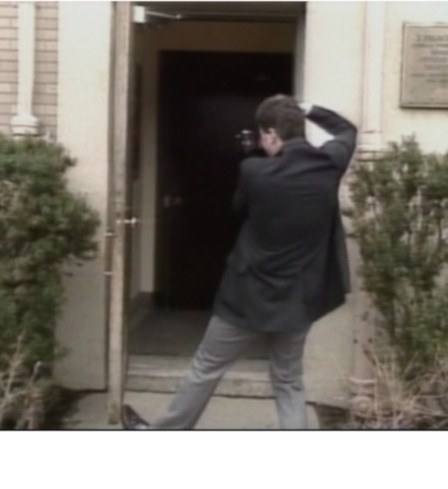
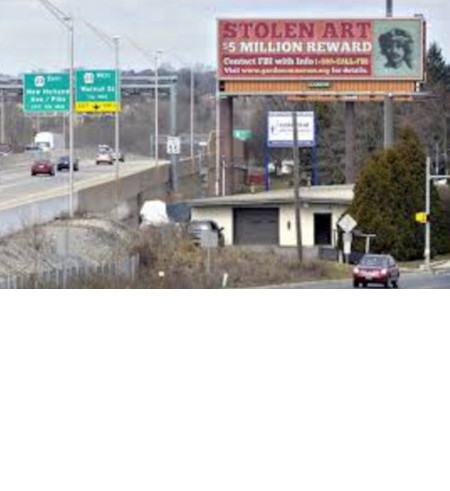
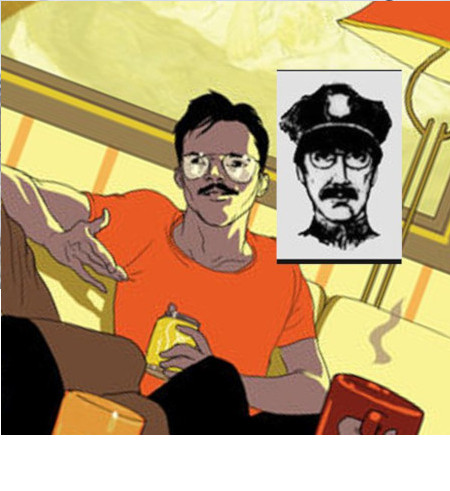
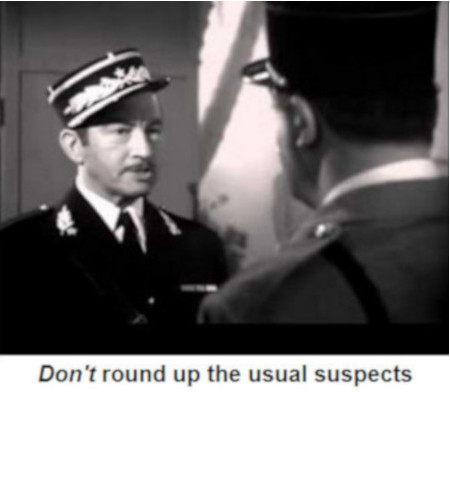
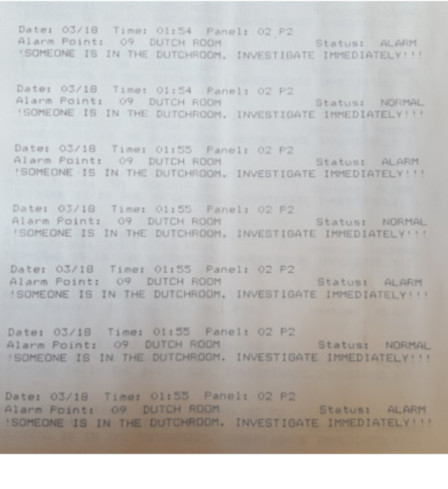

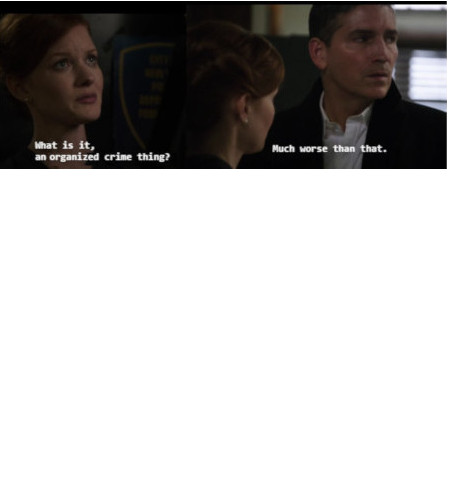

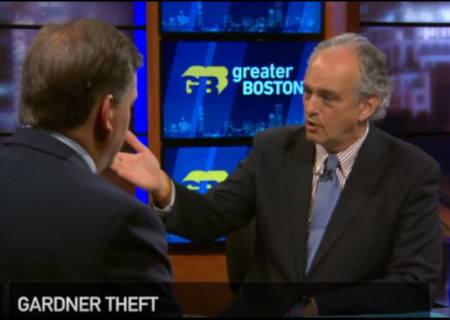
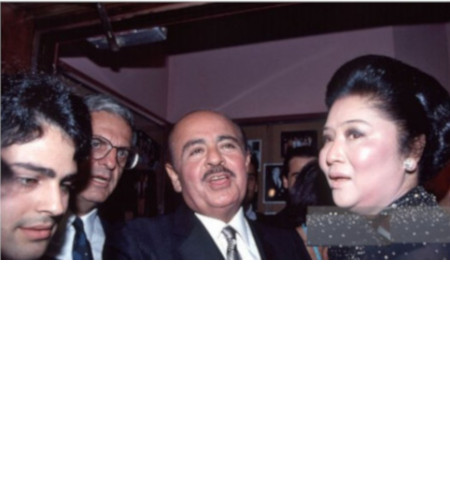

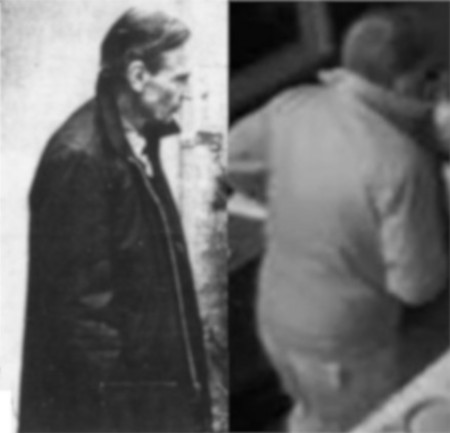
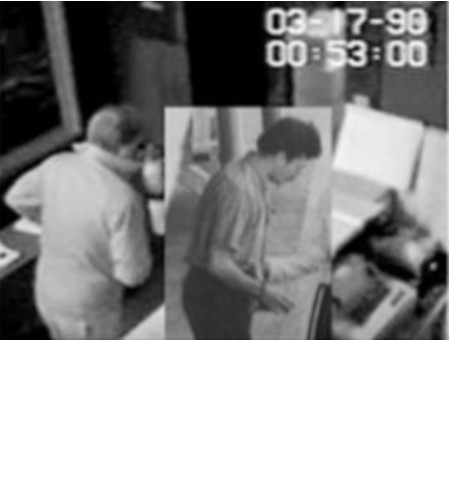
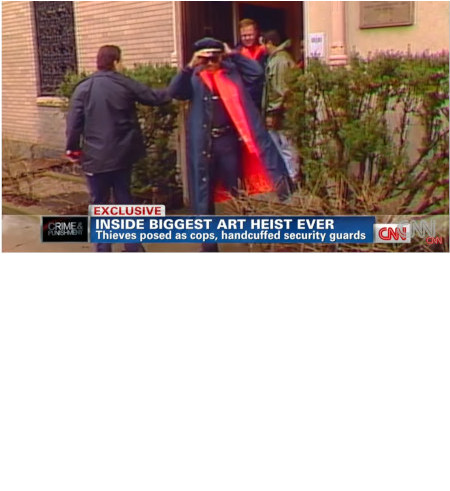
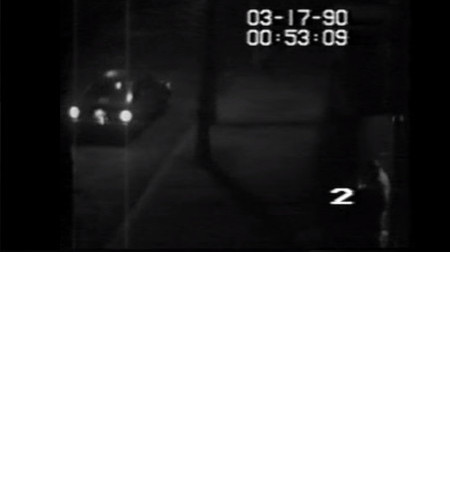

April 14, 2020: 43 Minutes
12:44 Museum fire alarm system inexplicably goes off. Guard Rick Abath abandons his rounds to respond to the alarm box in the basement. Abath shuts down the alarm system, which could pinpoint 30 places where a fire had started or a window broken. "Master Thieves" page 41.
12:53 Abath, on his rounds, passes through the Blue Room, where Manet's Chez Tortoni was stolen. It was the last time motion detector's picked up any activity in this gallery. The motion detector did not record any movement in that gallery during the time the thieves were in the building.
01:04 Against protocol, Abath opens and shuts the Palace Road door then returns to man the security desk.
01:24 Two men, ostensibly identified themselves as Boston Police officers investigating a disturbance around the building and against protocol were allowed entry by Abath.
01:26 Without explanation, Abath calls the other guard on a walkie talkie and says: "Will you please come to the desk?" The other guard, coincidentally coming down the stairs to his first floor rounds anyway, arrives in 10 seconds.
01:27 Abath steps out from behind desk, away from access to the only alarm linked to the police station.
January 8, 2020: What’s Behind The Latest Rift between the Gardner Heist Investigation and Arthur Brand
Perhaps because of the upcoming Gardner Heist 30th year anniversary, the New Year started off with a bang in that crawlspace where the Gardner heist investigation’s public relations effort is now stored. (It’s not a cool, dry place.)
Was it really twelve years ago now that Anthony Amore was saying he was “eager to deploy a ‘crowdsourcing’ approach to the crime, and use the Internet to distribute information and haul in data. ‘I know one thing,” Amore said, ‘I am not going to be able to recover these paintings on my own, in a vacuum, sitting here in an office. I need the collective intelligence of people from around the world.’"
That approach seemed to pay off in 2013. “Anthony Amore told the Boston Heald “it was a tip from a citizen in 2010 who called in with “new information about some matters that we had been looking into” that ultimately led to yesterday’s [March 18, 2013] blockbuster developments,”
Four years later, in 2017, Amore remained focused and determined, telling the New York Times, “I’ve spent more than a decade preparing for any scenario,” he said. “I’m very ready. I’ll go anywhere. I’ll meet with the devil for these paintings.”
By that time however, he had also seemed to have soured on receiving input from the public. “’We’re not looking for every armchair detective in Boston to send their theory,’ Amore said. “It’s been 27 years, and we’ve heard all the theories. Theories don’t lead to recovery. We’re looking for facts.’”
In a September 12, 2018 interview on Boston Herald radio, “Animal House Episode 39, Amore predicted that the then upcoming podcast, “Last Seen,” about the Gardner Heist, would lead to his being “flooded” with emails and phone calls. Notably, with his prediction came not even a smidgen of the optimism or hope of previous years. For Amore, it was obvious “crowd sourcing” had gone from opportunity to chore.
Additionally, Amore seemed intent, not only to discourage any input from members of the public but also to dismiss people who expressed views outside of a questionable and narrowly defined orthodoxy of the Gardner theft and the investigation, as cranks, crazies and conmen.
In that same Herald radio interview, when Hillary Chabot asked about Gardner heist guard Rick Abath’s statement that one of the Gardner Museum thieves looked like Colonel Klink, instead of just saying that Abath’s comparison had not led to any new developments, Amore replied. “I get a lot of theorists who send me pictures who look like Colonel Klink.”
Back in 2008, Amore said that the tips he receives “are projected against the total picture that I have in my database and in my memory. After you’ve studied this hard enough, you can do this mind-mapping thing where you do it in your head instantaneously.”
Indeed. But in 2018 Amore endorsed keeping the names of the thieves a secret, even though “the FBI did say the people we believe committed the crime are dead.” Because, “if I tell you who did it and we tell the public and this is my perspective, not the government's, I will go back to seven thousand phone calls on my desk from conmen…I am still to this day believe, it or not, inundated with phone calls and emails and letters, and most of the people are sending information that just send you down the wrong track, a lot of red herrings, so we need to focus, that's why we keep it proprietary.”
Real crowd sourcing in the case of the Gardner Heist would quickly turn into mob sourcing if the identify of dead thieves were released. Therefore, the investigation must resort to this policy of withholding the names of deceased known perpetrators, an investigative strategy that is unique in the annals of law enforcement in the United States.
By the end of 2018, Amore was ready to close off any meaningful exchange between the public and the investigation: "Don't believe the [Gardner Heist] books. Don't believe what you read in them. Suspend disbelief and know people are working really hard behind the scenes," Amore said on a podcast called The Horse Race, by WBUR pollster Steve Koczela (Time 27:26).
Suspend disbelief? So the crowd sourcing is crowd saucing. I’m hip. Keep the art in the public’s face as much as possible, while flooding the information space with a head spinning array of suspects and possibilities, give a wink to anyone trying to make sense of it all, and just leave this effort to the professionals. Roger that... um, I guess.
But that brings us to this New Year, and a couple art recovery professionals, in fact two very high profile professionals. First up, on January 1, 2020 was Chris Marinello, founder of Art Recovery International, which has “helped negotiate some of the most high profile restitution cases in recent years, such as the discovery and return of Matisse’s 1921 painting Seated Woman/Woman Sitting in Armchair, a Nazi-looted masterpiece.”
In his newsletter, on January 1st, Marinello announced that “with the consent of law enforcement,” he had “offered to serve as a pro-bono intermediary between the possessors and the museum. ARI will happily exchange the reward and artwork through attorney’s escrow. In this way, those collecting the reward will never have to deal directly with museum security or law enforcement.”
Interesting news. It sounds like a good idea. On Mob Talk #9, November 7, 2017, for example, Philly mob expert Dave Schratwieser reported that, according to one of his sources, organized crime “wants nothing to do with this.” The stolen Gardner art "is such a hot item, they want to be 100 miles away."
If mistrust has developed among certain, shall we say, segments of society, it makes sense to develop new channels of exchange for recovery of the art.
At this, Paul Hendry, a newcomer to twitter (@arthostage), but not to the Gardner Heist case, by any means,
tweeted out that same New Year’s day: “Gardner Museum & FBI Appoint Chris Marinello Official Pro-Bono Intermediary on the Gardner Art Heist case.” The tweet quickly garnered four likes, among the teeny-tiny universe of people on social media, who are thinking about the Gardner heist in January, not bad for a guy who had been on twitter for all of two weeks and had about a dozen followers.
That same day, however, Anthony Amore retweeted Hendry’s report with the comment: “Looks like the #FakeNews about the Gardner investigation in 2020 has started early. No one has been appointed anything by anybody.
Huh? Why was Amore, the “don’t believe the books, suspend disbelief guy” worked up about one little somewhat incorrect tweet by a guy in England with twelve followers? And then, Chris Marinello himself, was also critical, and harshly critical, of Hendry’s tweet the next day.
The use of the word “appoint” was an error, but in my view, an honest mistake, not #FakeNews certainly. Still, that term “appoint” could put someone off, if they were looking for a truly independent channel for returning the art and getting the reward.
The purpose, after all, is to provide a legitimate channel, not appointed by the “Gardner Museum & FBI.” It was important for Marinello, at least, to clarify the relationship, or in this case, the lack of one.
At the same time, there is not much point in being an independent channel, if no one knows about it. Paul Hendry is someone who subscribes to, and actually reads the Art Recovery International newsletter the day it comes out.
What followed next was a multi-day barrage of tweeted invective against Anthony Amore, with a little bit thrown in against Marinello by Paul Hendry, which kept the issue alive for a few days.
Since Arthur Brand was Hendry’s first follower on twitter, it is hard to believe Brand was unaware and missed the whole brouhaha over Hendry’s tweet of Marinello’s announcement. One way or another Brand knew about this initiative by Art Recovery International.
Then Brand tweeted: “Still working on the Isabella Stewart Gardner theft.” “And don’t believe those who say you can only deal with them. You can always talk with me. The FBI and the museum and their allies are not going to solve this case after 30 years. Move over,” reported Casey Sherman , a columnist in the Boston Herald,
Speaking to Brand by phone in Europe, he told me [Sherman] that he fired off the tweet in frustration and has since deleted the message.” After the Sherman column, though, consider how many people know about the Dutch investigator’s tweet now. File under “unintended consequences.” Or not. One question I have is, if Brand already has solid leads with people controlling some of the stolen Gardner Museum art, why is he trawling for new leads on twitter?
Later in his column Sherman wrote: “The FBI won’t comment on the art detective’s theory but when I reached out to Anthony Amore, the museum’s director of security, during an online conversation, he told me; “We have no comment on some guy’s (bleeping) twitter…” To call Arthur Brand ‘some guy‘ speaks to Amore’s institutional arrogance,” Sherman added.
Sherman pointed out that Brand is not "some guy." Dubbed "'The Indiana Jones of the Art World,' Brand made international headlines last year for finding and returning a $28 million Picasso painting that was stolen 20 years ago from a luxury yacht in the French Riviera.'"
The phrase "Some guy's (bleeping) twitter..." also illustrates the investigation's robust but nonetheless defensive posture. In his email, Amore switched the topic from the what, (the expressed need for an itemized stolen Gardner art price list), to the who (some guy) and the where (on twitter).
I would say refusing to give Brand an itemized price list might speak to institutional arrogance. Even if there is a back channel to make a transaction from Marinello or others, there is still the details of a deal to be hammered out and negotiated.
If a guy like Brand with a proven track record of recovering art says he needs an itemized price list, you would think they would just give it to him.
This treatment of Brand shows the formal Gardner theft recovery team is unwilling to delegate that portion of recovering the art. What is really of primary concern remains the provenance of any returned Gardner art.
As William Youngworth said on the documentary Stolen in 2005, before Anthony Amore knew anything about the Gardner heist: "The FBI takes this public posture that, listen we just want the stuff back, and we don't really care how it comes back. That's not true. I mean, I have sat there behind closed doors and they only have one agenda the only thing they want is names."
The number one priority remains making sure the original thieves do not benefit in any from the return of this stolen art. There will not be any deal with Arthur Brand, or Anthony Amore, or anyone else that involves any of the original thieves profiting from the robbery.
Give columnist Casey Sherman credit for calling into account one of Boston’s most sacred cows, the Gardner Museum heist investigation, and even putting a name and a face to it, though the ultimate responsibility belongs elsewhere, not with Anthony Amore.
Since the “Stolen” documentary came out, a few little additional facts have dribbled out, concerning what is known about the robbery. Bestowing a few facts on the public, however, came at the price of bestowing on the fact providers, the investigators, unchallenged control of the narrative, from a press growing more and more hungry for page views.
The problem with that is, as Callie Crossley observed on the WGBH program Beat The Press recently: When a fact is put in a context with a bunch of other b.s. then that degrades the actual fact. That is exactly what has happened with the Gardner heist story. People watching the documentary "Stolen" in 2005 had a better understanding of the Gardner heist; the investigation and the dynamics at play in the attempts at recovering the art, than people in 2020, because along a few little facts, has come a whole lot of um... spin.
Amore’s profanity garnished dismissiveness of the Dutch art recovery expert does demonstrate one thing, his complete certainty that the art is not coming back by way of Arthur Brand. It would be a serious misjudgment to think that Amore would let pride or arrogance stand in the way of getting the stolen Gardner returned.
Then, how can Amore be so sure Brand has no role to play? If not this year, then maybe five or ten years from now. That is the subject of my next blog post on Friday.
So how IS Amore so certain he can afford to burn this bridge with Arthur Brand? So sure
that Brand has nothing to offer now or in the future? Columnist Casey Sherman termed it an “online conversation,” when Amore said that “we have no comment on some guy’s (bleeping) twitter…” That means he had an opportunity to self edit his remarks, if he so desired. Amore hasn’t survived 15 years as unofficial explainer of a Gardner Heist investigation that keeps getting curiouser and curiouser, by being gaffe prone.
The effort to recover the stolen Gardner art is an active investigation. Activity means changes, though the public is not opted in on every development.
For example, on October 29, 2013, Amore said : "I haven't spoken to the thieves but I'm confident when the thieves went into the Gardner their assignment was Rembrandts.” [Time 1:110].
Just a year later, however, on November 12, 2014 Amore said: "I can't tell you specifics about the [Gardner Heist] thieves and what I know from them. All I can say about them is that they cannot lead us to the paintings today." Someone in the audience then asked what the question had been, and Amore replied: "The question was why can't the thieves lead us to the paintings and if I get into the weeds on that topic. I might be saying more than I should."
Over that one year period what Amore said in public about his knowledge of Gardner Heist related matters changed, very likely because of matters going on in the investigation that is not in public also changed. He even acknowledged that going into that topic “might be saying more than he should.”
Similarly, Amore’s public statements regarding Arthur Brand changed. In June of 2017, Brand predicated that he would have the stolen Gardner art back by the end of the year. This was just a few weeks after the Gardner Museum doubled the reward for return of the stolen art from $5 million to $10 million. The original story by Nina Siegal, in was in the Bloomberg European edition but the story with her byline was picked up by the Boston Globe and the Associated Press.
In that story Siegal wrote: “But there is one outside detective respected by Amore — Arthur Brand, a Dutch private investigator — who believes not only are the artworks still intact, but also that he can bring them home.” The article quoted Amore saying: “There are very few like him who understand the reality of this sort of crime.”
So how did this guy Brand become “some guy” in less than three years despite having made international headlines for his successful art recovery efforts during that period?
A lot of what happens in the Gardner Heist art recovery effort has to do with an certain kind of provenance, a clean break with the original thieves.
After William Youngworth claimed he could return the art, he complained: “They only have one agenda the only thing they want is names." William Youngworth obliged them. He said that the paintings were taken by Robert Donati, and David Houghton, both long dead. The pair had taken the art to spring Myles Connor for prison, as Connor had been claiming since 1992. (The fact that investigators persisted in asking Youngworth for names is one more reason to believe that the thieves were not Bobby Donati and David Houghton.)
But even if the paintings were not taken by the I.R.A. someone could be trying work through the I.R.A. and from the I.R.A. through Brand, as a channel to ransom the art back to the Museum. But as with William Youngworth, Brand and his contacts in Ireland would have to divulge names. They would have to be able to prove that the original thieves did not stand to benefit.
Initially Amore seemed to have kept an open mind, about Brand's bold claim, and it is hard to believe that Brand, even with all of his media savvy, would have made anything like the same kind of publicity splash in saying he could get the stolen Gardner art back by then end of 2017, without Anthony Amore, in effect vouching for him, in that initial story.
Two years later though, July 5, 2019, Amore told the Daily Beast, "he doesn’t do deals with thieves, even if it might mean the safe return of the treasures. 'Art hunters like Arthur Brand often negotiate with the smugglers and thieves, but is that something you can condone?' he asks. 'Anybody that can help us get our art back and acts ethically to do so is welcome, but the idea of paying thieves [for] art is unethical.'” Amore said.
In the original story, Brand was a "detective," in this July 2019 story, though he was an "art hunter." In any case Amore makes it quite plain, that as with Youngworth and others, there will be no deal for the Gardner art with the Gardner heist thieves. History as shown that even if the Museum wanted to pay off the thieves, as has been the case with numerous art thefts from museums, galleries and homes in the past. the FBI will not let the Museum make a deal with the thieves.
After Hawley left as director of the Gardner Museum and had taken a position as a resident fellow at the Harvard Kennedy School of Government, she said: “I’ve had complex experiences with the FBI as well as the Boston crime underworld. Early in the investigation, I was threatened with the charge of obstruction of justice when pursuing privately a lead that promised to crack open the investigation.”
Later, in 1994, the Gardner Museum received a ransom demand for $2.6 million for return of the stolen art. The Museum was clearly willing to meet the terms of the ransom note writer but the FBI clearly was not. A second letter arrived from the ransom note writer stating:
“I think it important to say right now that you have a choice, that is you may be able to apprehend a low-level participant who has been kept in the dark or you can recapture the entire collection intact. YOU CANNOT HAVE BOTH."
"Hawley was dumbfounded. She had impressed on Swensen and others at the FBI her hope that the letter writer was legitimate and that everyone needed to follow his instructions to the letter."
"That word had filtered down to the handful of agents who were directly responsible for the case."
“'We were told to stand down by Swensen, and that’s exactly what we did. No calls were made, no one was interviewed,” says one agent working the case at the time."
"However, he said, that word may not have reached everyone inside the bureau. Agents in the Boston and New York offices were working feverishly to track down the letter writer’s identity, the agent said."
“'There was no complete stand-down,' the agent admitted. 'Far from it.'” Master Thieves by Stephen Kurkjian [pages 81-82].
But things change. The policy could change. Brand might have seen the announcement on January 1, 2020, by Chris Marinello, that he had been cleared to serve as an independent escrow, as a sign of change, or he might have been adding himself to the efforts of those who want a change in policy, which would allow someone to return the art for the reward no questions asked, instead of many, many questions asked, as has been the case in the past.
Without knowing where the art is, the investigation may know not only who did the Gardner art heist, but who controls it.
PART THREE
If the stolen Gardner art is held hostage, simply knowing who the thieves are, and even knowing who controls the art would not necessarily translate into getting it back. During the Iranian hostage crisis, which began in 1979, for example, the United States knew who had taken American citizens, they knew who controlled these hostages, they even knew where these hostages were located, but it still took 444 days to get them freed.
The FBI’s Geoff Kelly, who has spearheaded the Gardner heist investigation for 18 years, and former Gardner Museum director Anne Hawley, who was the museum director form the time of robbery in 1990 until 2015, have both stated that at times they were convinced the Gardner art would soon be returned, only to have their hopes dashed. There have been numerous contacts with people who have persuaded the authorities, the museum, and investigators that they could return the Gardner art, or that they have specific knowledge of its whereabouts.
Several offers to return the stolen Gardner art were covered by the news media. While some were hoaxes, some credible offers also appear to have been made, or never fully discredited. A major stumbling block seems to be that a member or members of the original group, who robbed the Gardner museum, still control the art.
Although the FBI began saying the thieves were dead in 2015, while hinting about criminals who died shortly after the robbery, just two years earlier in 2013, the FBI had said that as late as 2003, the art was still known to be controlled by the thieves:
“’The FBI believes with a high degree of confidence in the years after the theft the art was transported to Connecticut and the Philadelphia region and some of the art was taken to Philadelphia where it was offered for sale by those responsible for the theft .’ Richard DesLauriers, special agent in charge of the Boston office of the FBI, said.”
“Tell them they’ll be hearing from us,” the intruders told the guards,” but we only have the words of reporters like, Stephen Kurkjian, without sourcing that “they’re never heard from again.”
We now know that people who purported to have the art or information about the art were ignored by the authorities. Investigators were not even interested in speaking to potentials thieves, in some cases, early in the investigation.
In October of 2013, the museum director Anne Hawley said that shortly after the theft. "The museum was experiencing these bomb threats coming from people in penitentiaries that were trying to negotiate with the FBI on information they
said they had — and the FBI wasn’t responding to them so they were hitting us.”
Hawley reiterated those claims, which had never been reported in the press until 2013, on camera, six weeks later: “We also were being threatened from the outside by criminals who wanted attention from the FBI, and so they were threatening us, and threatening putting bombs in the museum,” “We were evacuating the museum, staff members were under threat, no one really knew what kind of a conundrum we were in.”
Why were these bomb threats never reported to or by the media until decades later? Why did the FBI refuse to contact these people, as Hawley says, if for no other reason than to prosecute them for threatening the museum and staff, or at least get them to stop?
Hawley retired as director of the Gardner Museum at the end of 2015, but only a few months later, as a resident fellow at Harvard’s Institute of Politics, she wrote: “Early in the [Gardner heist] investigation, I was threatened with the charge of obstruction of justice when pursuing privately a lead that promised to crack open the investigation.
This is backward. Instead of the robbers threatening the victim not to contact law enforcement, you have law enforcement
threatening the victim, not to contact the robbers, and criminals threatening the victims to contact the FBI.
Later, in 1994 there was a ransom note, which Hawley considered the most credible lead the museum ever received during her tenure, but did not result in the return of the stolen Gardner art, possibly because of
the FBI’s unwillingness to “stand down” as was stipulated in the note:
“Hawley was dumbfounded. She had impressed on Swensen and others at the FBI her hope that the letter writer was legitimate and that everyone needed to follow his instructions to the letter. That word had filtered down to the handful of agents who were directly responsible for the case.”
“We were told to stand down by Swensen, and that’s exactly what we did. No calls were made, no one was interviewed,” says one agent working the case at the time. However, he said, that word may not have reached everyone inside the Bureau. Agents in the Boston and New York offices were working feverishly to track down the letter writer’s identity, the agent said. “There was no complete stand-down,” the agent admitted. “Far from it.” —Master Thieves page 80-81
Once again in 1997, the Museum demonstrated a willingness to make a deal with someone who claimed they could get at least some of the stolen Gardner art back, William Youngworth. But authorities were not persuaded he was being truthful about some aspects of his story, and would not guarantee him and other parties immunity from prosecution if they returned the art for the reward.
In 2005 documentary “Stolen,” Younworth said: "The FBI takes this public posture that ‘listen we just want the stuff back and we don't really care how it comes back.’ That's not true. I mean I have sat there behind closed doors and they only have one agenda the only thing they want is names. In another interview, five years earlier he said: "’Basically, the FBI’s currency is image. If they can't kick in a door and hold a press conference, then they don't want to deal with it,’"
Twenty years later, the FBI is still dealing with it and the effort has done nothing to bolster or preserve a positive “image” for the FBI. Youngworth may have had a point, though, about the FBI wanting “to kick in a door,” but in the sense of not being willing to negotiate a return. The same Guardian article reported: the “attorney general’s office in Washington warned against pandering to “cultural terrorism,” a statement that would seem to suggest an unwillingness to negotiate anything of value in return for the art.
The only deals offered to Carmello Merlino and Robert Gentile, who also had made claims of having access to the missing Gardner artworks, were the dropping of Gardner theft related charges, as well as charges brought about as the direct result of efforts initiated by informants in an effort to get the art back. “Why would Mr. Gentile not lead investigators to the missing trove and collect a share of the $5 million reward being offered by the museum?” Gentile’s lawyer asks. It’s truly a hypothetical question since, if a reward offer was made to Gentile, it has never been made public.
While there are those who decry the practice and warn against it, there are numerous examples in the news media of museums making a deal with thieves for the return of stolen art.
In the early 2000s the Tate Gallery in London successfully negotiated for the return of two J. M. W. Turners that were stolen in 1994 while on loan. Having bought back the title to the paintings from the insurers, the Tate delivered around $5.6 million to a lawyer, for information leading to the return, but some in the art world interpreted it as a ransom. British and German authorities approved the exchange.)
Others have stood firm against paying a ransom. Five Old Master paintings, worth millions, stolen in East Germany’s most notorious art heist were recovered after 40 years it was reported this month. “The art was quietly returned last September, arriving in Berlin by van, and no ransom was paid.”
Whether it is ethical or practical to pay a ransom, the Gardner heist may be unique in the way that law enforcement authorities have been so actively involved in preventing the museum from paying the reward, making a deal, getting their art back, on terms the museum at least, finds acceptable, even if law enforcement does not.
The Gardner Museum has at times seemed to demonstrate a willingness to pay a ransom for the return of their artworks, no questions asked, although their words on the topic have been less than unequivocal.
The Boston Globe did report in 2017 that: “Anyone, aside from the thieves themselves, is eligible for the full reward, Anthony Amore said.” In 2019, however, he was quoted by the Daily Beast that: "Thieves, or anybody holding the stolen Gardner art, can go through an attorney to get the reward.”
Also in 2019, a lead story in the Boston Herald last year began: "To the two thieves posing as Boston cops who ripped the soul out of the Isabella Stewart Gardner Museum nearly three decades ago: There’s $10 million waiting for you, no questions asked." The museums actions and most recent words suggest a willingness to negotiate with anyone, even the thieves who stole the art. If the Museum is not willing to pay a reward that might financially benefit the thieves, they have failed to make that position clear.
If it turns out that the art is in Ireland, as Arthur Brand claims, and comes with a murky backstory as to “the who” and “the where,” stretching back to the pre-Good Friday Agreement days of the Irish Republican Army, federal authorities may be limited in their jurisdictional authority to hold up a deal, that the Museum is willing to make. Any agreement would have to be sanctioned or approved by law enforcement authorities in the United States.
Would American officials have the inclination and clout to block a deal consummated in another country, with a non-criminal, such as Arthur Brand, given their own lack of credibility and success in investigating the Gardner robbery and making a recovery?
William Youngworth tried to take his case to the media and lost, but the media landscape has changed quite a lot in the past 20 plus years. Dubbed the Indiana Jones of art recovery, Arthur Brand has a stronger personal reputation than Youngworth too and he is more skilled in media relations. As a law-abiding citizen of the Netherlands, not the United States there may be limits on what federal authorities can do if the Museum is intent on accepting a deal for the art offshore in such a case.
Youngworth had his advocate of sorts in the Boston Herald’s Tom Mashberg, only after he was in the thick of negotiations, which were rapidly turning sour. In contrast, the groundwork is already laid for Brand, who regularly garners press attention for his art recovery exploits, and even has a Boston Herald columnist, author Casey Sherman, taking his part over differences he has with Gardner Museum director Anthony Amore over the direction of the stolen Gardner art recovery effort, or perhaps more accurately with differences Amore has with Brand, over his criticism of the investigation.
Some may remember that a production company co-owned by Sherman, bought the film rights “Stealing Rembrandts” a 2011 nonfiction book written by Amore and Mashberg. Although often misidentified as a book about the Gardner Heist by the Boston Globe , it is actually about several high profile stolen Rembrandt cases that “omitted the Gardner case because Mr. Amore said the hunt [for the stolen Gardner art] had reached a delicate phase. ”Mashberg explained in an article about new development in the Gardner heist investigation for the New York Times in 2015 called “Isabella Stewart Gardner Heist: 25 Years of Theories”
“We have a strong vision for this film and are excited to be partnering with two renowned art theft experts such as Amore and Mashberg on this project,” Sherman said in a statement.
It is hard to know how the Museum and American federal law enforcement would respond if Arthur Brand and his media accessorized art recovery juggernaut tendered an offer to return the stolen Gardner art in exchange for the reward from oversees.
PART TWO
